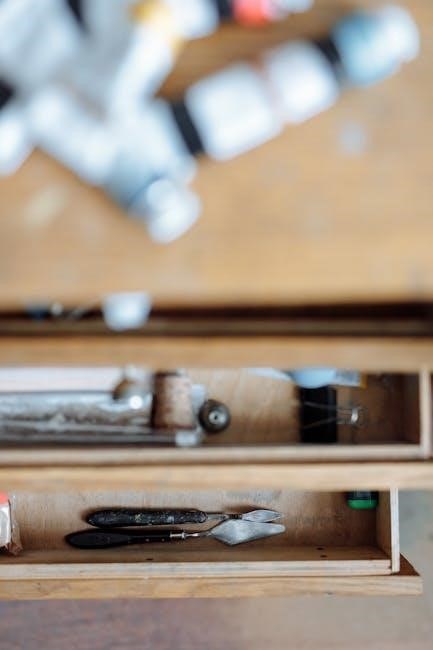Welcome to the Frigidaire Gallery Refrigerator Ice Maker Manual, your comprehensive guide to understanding features, installation, maintenance, troubleshooting, and efficient operation for optimal performance and longevity.
Overview of the Frigidaire Gallery Series
The Frigidaire Gallery Series is a line of high-quality, innovative appliances designed to combine style, functionality, and advanced features for modern kitchens. Known for its sleek designs and user-friendly interfaces, the series includes top-freezer and French door refrigerators with built-in ice makers. These models are engineered to provide efficient cooling, customizable storage options, and smart technologies to enhance daily convenience. The Gallery Series is popular for its reliability, energy efficiency, and seamless integration into contemporary home décors. With features like automatic ice makers and advanced temperature controls, it offers a perfect blend of performance and sophistication for homeowners seeking durable and feature-rich appliances.
Key Features of the Ice Maker
The Frigidaire Gallery ice maker is designed for convenient and efficient ice production, offering an 8-cube capacity per cycle. It automatically produces ice once the storage bin is installed and water supply is connected. The ice maker features a sleek, compact design that integrates seamlessly with the refrigerator. It includes a wire signal arm to control ice production and an easy-access storage bin for quick retrieval of ice. The unit is energy-efficient and built to last, ensuring consistent performance. With optional accessories and customizable settings, it enhances your refrigeration experience while maintaining user-friendly operation.

Installation Requirements for the Ice Maker
Ensure the refrigerator is installed on a level, stable floor capable of supporting its full weight. Check water supply availability for proper ice maker operation.
Water Supply and Plumbing Needs
A dedicated water supply line is essential for the ice maker to function properly. Use a high-quality, food-grade tubing to connect the refrigerator to a water source. Ensure the water supply valve is easily accessible and fully open. The refrigerator’s water inlet valve connects to the household water supply line, typically requiring a 1/4-inch OD tubing. Proper installation prevents leaks and ensures consistent ice production. If installing an aftermarket ice maker, follow the provided kit instructions carefully. Always turn off the water supply before connecting or servicing the ice maker to avoid water damage or flooding. Refer to the manual for specific plumbing requirements.
Leveling the Refrigerator for Proper Ice Maker Function
Proper leveling of your Frigidaire Gallery refrigerator is crucial for the ice maker to function correctly. Ensure the refrigerator is installed on a level, sturdy floor to support its weight when fully loaded. Use adjustable legs or shims to achieve even balance, checking both front-to-back and side-to-side alignment with a level tool. Improper leveling can cause the ice maker to malfunction or produce uneven ice. After leveling, verify the floor’s strength to handle the appliance’s weight. This ensures optimal performance and prevents potential damage to the ice maker or refrigerator. Always refer to the manual for specific leveling instructions tailored to your model.

Electrical Requirements and Safety Precautions
Your Frigidaire Gallery refrigerator ice maker requires a dedicated 120V, 60Hz electrical outlet. Ensure the circuit is grounded and can handle the appliance’s power demands. Avoid using extension cords, as they may cause voltage drops or fire hazards. If installing near water sources, use a GFCI-protected outlet to prevent electrical shocks. Never operate the refrigerator in areas with explosive fumes or where water is present. Disconnect power before performing any maintenance or repairs. Use a surge protector to safeguard against power spikes. Always follow safety guidelines in the manual to avoid electrical risks and ensure reliable operation.

Maintenance and Care Tips
Regularly clean the ice maker and storage bin to prevent mold and bacteria. Replace the water filter every 6 months for fresh ice. Check for blockages in the ice chute and ensure proper water flow. Dry the interior after cleaning to prevent odors and maintain efficiency.
Daily Cleaning and Hygiene Practices
Regular daily cleaning is essential for maintaining hygiene and efficiency. Wipe the ice maker and surrounding areas with a soft cloth to remove splashes or spills. Clean the ice chute and dispenser regularly to prevent blockages and bacterial growth. Use a mild detergent and warm water for cleaning, avoiding harsh chemicals that could damage surfaces. Dry all surfaces thoroughly after cleaning to prevent water spots and odors. Ensure the water dispenser and ice maker are free from debris. For optimal performance, check and clean the water filter as recommended in the manual. Consistent upkeep ensures fresh, clean ice production and prevents contamination. Regular maintenance also extends the lifespan of your appliance.
Deep Cleaning the Ice Maker and Storage Bin
For deep cleaning, turn off the ice maker and empty the storage bin. Remove any remaining ice and wash the bin with a soft brush and mild detergent. Rinse thoroughly and dry to prevent water spots. Sanitize the bin with a mixture of equal parts water and white vinegar. Wipe down the ice maker’s interior and exterior, paying attention to crevices where debris may accumulate. Use a clean, damp cloth to remove any residue or mineral buildup. Allow all parts to air dry before refilling the bin. Regular deep cleaning ensures fresh-tasting ice and prevents mold or mildew growth; Perform this process every 1-2 months for optimal hygiene and performance.
Replacing the Water Filter for Optimal Performance
Replacing the water filter in your Frigidaire Gallery refrigerator is essential for maintaining clean ice and water. Locate the filter, typically found in the rear or bottom of the fridge. Turn off the water supply before removing the old filter. Install the new filter by aligning it correctly and twisting it into place. Run a few gallons of water through the dispenser to flush out any impurities. Replace the filter every 6 months or as indicated by the manufacturer to ensure optimal performance and prevent issues like reduced ice production or unpleasant odors. This simple maintenance step ensures fresh, clean ice every time.

Troubleshooting Common Ice Maker Issues
Troubleshooting your Frigidaire Gallery ice maker involves identifying common issues like no ice production, jams, or low output. Consult the manual for diagnostic steps and solutions to restore functionality quickly and efficiently.
Ice Maker Not Producing Ice: Possible Causes and Fixes
If your Frigidaire Gallery ice maker stops producing ice, check the water supply line for kinks or blockages. Ensure the water valve is fully open and properly connected. Verify that the ice maker switch is turned on and the wire signal arm is in the correct position. Low water pressure or a faulty water inlet valve can also cause issues. Check the freezer temperature; it should be set below 8°F for proper ice production. If the problem persists, refer to the manual for diagnostic steps or consider replacing the water filter, as a clogged filter can restrict water flow to the ice maker.
Ice Jam or Blockage: How to Resolve
If your Frigidaire Gallery ice maker experiences a jam or blockage, start by turning off the ice maker and allowing the ice to melt completely. This helps clear any frozen obstructions. Check the ice chute and auger for blockages and gently remove any loose ice particles. Ensure the ice maker and bin are properly aligned to prevent misfeeding. Regularly cleaning the chute and ensuring proper airflow can help avoid future jams. If the issue persists, consult the manual for specific troubleshooting steps or consider professional assistance to restore smooth ice production.
Low Ice Production: Adjusting Settings and Usage Patterns
Low ice production in your Frigidaire Gallery ice maker can often be resolved by adjusting settings and usage patterns. Ensure the ice maker switch is turned on and the freezer temperature is set correctly (typically below 10-15°F). Check the ice maker’s water supply for proper flow and ensure the water filter is clean or replaced as needed. Avoid frequent door openings, as this can disrupt the cooling process. If ice production remains low, adjust the ice maker’s settings to increase output or run a cleaning cycle. Regular maintenance, such as clearing ice buildup and ensuring proper alignment, can also improve efficiency. Always refer to the manual for specific guidance.
Strange Noises from the Ice Maker: Diagnosis and Solutions
Strange noises from your Frigidaire Gallery ice maker, such as clunking, grinding, or rattling, can indicate issues with its operation. These sounds often occur due to improper installation, misaligned parts, or ice buildup. To diagnose, check if the ice maker is level and secure. Ensure the water supply is stable and not causing vibrations. If grinding persists, inspect for blockages or frozen ice cubes. Cleaning the ice maker and ensuring proper water flow can resolve many issues. For persistent noises, refer to the manual for specific troubleshooting steps or contact a professional. Regular maintenance and adjustments can prevent recurring problems.

Operating the Ice Maker Efficiently
Understand the ice maker’s production limits and customize settings for energy efficiency. Monitor usage patterns and adjust as needed for optimal performance and energy savings.
Understanding Ice Production Capacity and Limits
The Frigidaire Gallery ice maker produces approximately 3 to 4 pounds of ice every 24 hours, depending on usage and conditions. To ensure efficient operation, monitor your ice needs and adjust settings accordingly. Excessive demand may strain the system, while lower usage can help conserve energy. Factors like freezer temperature, water supply, and humidity also impact production. Regular maintenance, such as cleaning and filter replacement, is crucial for maintaining capacity. Always refer to the manual for specific guidelines tailored to your model. Proper installation and leveling of the refrigerator further ensure optimal ice production and longevity of the ice maker.

Customizing Ice Maker Settings for Energy Efficiency

To optimize energy efficiency, adjust your Frigidaire Gallery ice maker settings based on your needs. Use the smart sensors to monitor ice levels and automatically halt production when the bin is full. Lowering the freezer temperature slightly can reduce energy consumption while maintaining ice production. Consider disabling the ice maker during extended periods of low usage or when energy conservation is a priority. Regularly reviewing and customizing these settings ensures the appliance operates efficiently without unnecessary energy waste, helping you save on utility bills while still enjoying convenient ice production.

Additional Features and Upgrades
The Frigidaire Gallery refrigerator offers optional accessories like advanced water filters and smart home integration. Energy-saving modes and customizable settings enhance functionality and efficiency, ensuring optimal performance tailored to your needs.
Optional Accessories for Enhanced Functionality
Enhance your Frigidaire Gallery refrigerator’s capabilities with optional accessories designed to improve convenience and performance. The ice maker can be upgraded with a premium water filter to ensure cleaner ice production. Additionally, smart home integration kits allow remote monitoring and control of your refrigerator’s settings. For added versatility, consider purchasing an extra ice storage bin or a dispenser accessory for easier access to ice. These accessories are engineered to seamlessly integrate with your appliance, providing enhanced functionality without compromising performance. Always use Genuine Frigidaire parts to ensure compatibility and maintain optimal operation. Explore these accessories to elevate your refrigerator’s features and user experience.
Energy-Saving Modes and Smart Features
The Frigidaire Gallery refrigerator offers advanced energy-saving modes and smart features to optimize performance while reducing energy consumption. The Energy Saver mode adjusts settings to minimize power use during periods of low activity. Smart home integration allows users to monitor and control the refrigerator via a mobile app, ensuring efficient operation. Features like voice command compatibility with smart assistants enhance convenience. Additionally, the refrigerator’s intelligent sensors automatically adjust cooling levels based on usage patterns, helping to conserve energy without compromising performance. These innovative features not only lower utility bills but also contribute to a more sustainable household, making the Frigidaire Gallery a modern and eco-friendly choice.